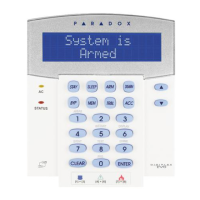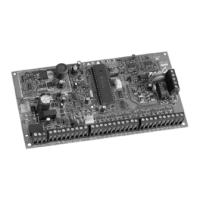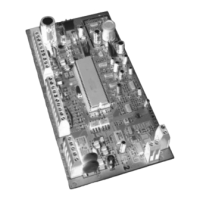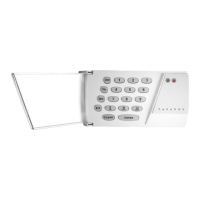Do you have a question about the Paradox MG32LED and is the answer not in the manual?
| Brand | Paradox |
|---|---|
| Model | MG32LED |
| Category | Control Panel |
| Language | English |
Table for configuring user access, partitions, and permissions.
Steps for adding, modifying, or deleting users.
Configuration of entry, exit, and bell cut-off delays.
Setting the system's current time and date.
Instructions for communicating with WinLoad software.
Configuring phone numbers and pager for communication.
Sending a test report to the monitoring station.
Setting up automatic arming schedules.
Erasing lost remote controls from the system.
Adjusting system behaviors like siren squawk and exit delays.
Understanding auditory and visual feedback from the keypad.
Details on beep tones and indicator lights for system status.
Overview of MG10LEDV keypad and its indicators.
Description of the 32-zone LED keypad and its zone display.
Description of the 32-zone wireless keypad and its indicators.
How the system can be divided into partitions for different security areas.
Procedures for activating and deactivating StayD mode.
Switching between Stay, Sleep, and Full arming modes.
Managing interior zones and re-arm delay in StayD mode.
Types of access codes and their functions.
Information about the primary master code and its capabilities.
Functions of master codes assigned to specific partitions.
Using a code to transmit a silent alert during duress.
Step-by-step guide to creating new access codes.
Procedure for removing existing access codes.
Steps to arm all zones in a partition.
Arming the perimeter and main floor while allowing bedroom access.
Arming the perimeter while allowing movement within the premises.
Arming the system without an access code via the ARM key.
Arming the perimeter without an access code via the STAY key.
Arming Sleep zones without an access code via the SLEEP key.
Accessing bypass mode quickly using the BYP key.
Exiting premises while keeping the system armed.
Setting automatic arming times for the system.
System arming based on detected inactivity.
Procedure for disarming an armed system or an alarm.
Temporarily deactivating specific zones.
Restoring previously saved zone bypass settings.
Selecting how the keypad displays zone events.
How alarms are indicated on the keypad LEDs.
Steps to take in case of a fire alarm.
Information on common causes and prevention of home fires.
General advice for fire safety and escape planning.
Recommendations for installing smoke detectors.
Setting up panic alarms for police, medical, or fire emergencies.
Enabling chime alerts for specific zone openings.
Disabling audible beeps on the keypad.
Modifying the brightness level of the keypad display.
Using programmable outputs for various system functions.
How the keypad display conserves power.
Accessing and interpreting system trouble conditions.
Descriptions of various system trouble codes.
Steps to reset the system's clock due to Timer Loss.
Using shortcut keys for specific functions like test reports.
Recommended procedures for testing system components.
A table to record zone settings and attributes.
Recording zone details and system partition status.
Configuring panic alarm types and PGM assignments.
Setting exit and entry delay timers for partitions.
Indicating which special keys are activated.
Details on product warranty, limitations, and legal notices.











